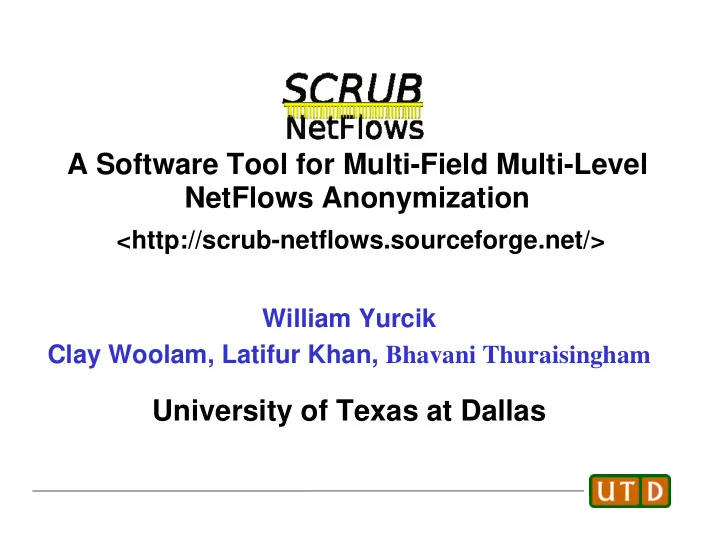

A Software Tool for Multi-Field Multi-Level NetFlows Anonymization <http://scrub-netflows.sourceforge.net/> William Yurcik Clay Woolam, Latifur Khan, Bhavani Thuraisingham University of Texas at Dallas The University of Texas at Dallas
Motivation: Anonymization? Anonymization enables entities to share types of data that would otherwise not be shared (1) Private Data – User-identifiable information • user content (Email messages, URLs) • user behavior (access patterns, application usage) – Machine/Interface addresses • IP and MAC addresses (2) Secret Data – System configurations (services, topology, routing) – Traffic patterns (connections, mix, volume) – Security defenses (firewalls, IDS, routers) – Attack impacts The University of Texas at Dallas
Motivation: Sharing? Chasing attackers away (to other organizations) • does not improve security Security data is needed between organizations to • correlate events across administrative domains (cumulative learning between organizations) – Detect attacks – Blacklist attackers and attacker techniques – Distinguishing between normal and suspicious network traffic patterns The University of Texas at Dallas
SCRUB* Infrastructure packet traces commands processes (2) (1) SCRUB-PACCT SCRUB-tcpdump Organization Other MSSP Enabled for Organizations Distributed CERT ISAC Sharing (4) (3) SCRUB-Alerts SCRUB-NetFlows CANINE (format converter) Virus IDS Firewall NetFlows (Cisco, Argus, IPFix) The University of Texas at Dallas
CANINE (Flocon’05) a NetFlows Converter/Anonymizer • CANINE: Converter and ANonymizer for Investigating Netflow Events <http://security.ncsa.uiuc.edu/distribution/CanineDownLoad.html> • Converter – Cisco V5 & V7, ArgusNCSA, CiscoNCSA, NFDump • Anonymizer – 5 NetFlow fields (multi-field) (1) IP, (2) Timestamp, (3) Port, (4) Protocol, (5) Byte Count – Multiple options for each field (multi-level anonymization) • Java GUI – easy to use point-and-click The University of Texas at Dallas
IP Address Anonymization in CANINE The University of Texas at Dallas
(Flocon’08) New & Improved NetFlows Anonymizer • ASCII-based PERL code – works on any NetFlows format converted to ascii – optimized code (multi-threaded parallelization) • Anonymizes more NetFlow fields (10>5) – adding support for additional fields is minimal – (6) TimeStamp (first/last pkt) (7) TOS (8) TTL (9) TCP Flags (10) Packet Count • Improved/More anonymization options per field – Fixes Crypto-PAn IP address anonymization flaw – Working on tailoring semantics to low/medium/high • Command line operation – UNIX friendly, consistency with other SCRUB* tools – cascaded streaming operation available via piping The University of Texas at Dallas
SCRUB-NetFlows Multi-Level Anonymization Options • Black Marker (filtering/deletion) • Pure Randomization (replacement) • Keyed Randomization (replacement) • Annihilation/Truncation (accuracy reduction) • Prefix-Preserving Pseudonymization (IP address) • Grouping (accuracy reduction) – Bilateral Classification • Enumeration (time, adding noise) • Time Shift (time, adding noise) The University of Texas at Dallas
Example: Timestamp Field (First/Last Pkt) • Black Marker – replacement of field with a predefined constant (0) • Random Time Shift – increments given time by a random value within a user defined window • Enumeration – sorts entries by timestamp, applies black-marker • Distance-preserving pseudonymization – preserve distance between two timestamps • More – including pure/keyed randomization, truncation, unit annihilation The University of Texas at Dallas
Addressing Crypto-PAn Flaw in SCRUB-NetFlows • Crypto-PAn is widely used for prefix-preserving pseudonymization – flaw discovered – attacker can reverse-engineer the original prefix mapping in a given dataset • Our use of Crypto-PAn – Begin with two separate instances of Crypto-PAn with two distinct keys: Crypt1 and Crypt2 – Determine network and host portion of IP address – Run Crypt1 and Crypt2 on the IP address – Return the network of Crypt1 concatenated with the host given by Crypt2 The University of Texas at Dallas
Example usage • Anonymizations done on one line of an Argus NetFlow – The program is told to black marker the source IP, randomize the destination IP, and black marker the first timestamp The University of Texas at Dallas
Anonymization for Sharing: The Privacy vs. Analysis Tradeoff while anonymization protects against information leakage it also destroys data needed for security analysis – Zero-Sum? (more privacy <> less analysis & vice versa) – We are now making measurements of the tradeoff • another story but we can talk off-line The University of Texas at Dallas
Summary • Critical need for security data sharing between organizations • Anonymization can provide safe security data sharing – Multi-Field: prevent information leakage – Multi-Level: no one-size-fits-all anonymization solution • SCRUB-NetFlows as part of a data sharing infrastructure (SCRUB*) supporting multiple data sources – NetFlows is not the only data source of interest • No “One-Size-Fits-All” anonymization policy – multi-level anonymization options can/should be tailored to requirements of sharing parties to optimize tradeoffs – privacy/analysis anonymization tradeoffs need to be characterized The University of Texas at Dallas
Recommend
More recommend